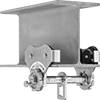Filter by
Weight Capacity
Power Source
Application
OD
Mount Type
Shaft Diameter
Height
Clearance
Bearing Type
Export Control Classification Number (ECCN)
Beam Width
DFARS Specialty Metals
Body Material
Length
Material Handling
Measuring and Inspecting
Fabricating and Machining






































